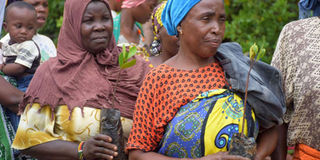Women fighting environmental degradation targets of attack

January 8, 1999 is a day etched in the minds of many environmentalists. It is the day staunch environmental activist the late Prof Wangari Maathai was attacked in Karura Forest as she planted trees to save the ecosystem.
Prof Maathai, who won a Nobel Prize in 2004, for her stewardship in environmental conservation, had vehemently objected excision of parts of the forest for private development.
She persistently led supporters of Green Belt Movement, which she founded in 1977, to Karura Forest to plant trees, notwithstanding the dangers she exposed herself to.
Prof Maathai is remembered as a brave woman who went against the grain to challenge the government of the day regime on matters of environment.
Apart from the beatings she got for protecting the environment, Kenya’s second President the late Daniel Arap Moi angered by her protests to protect forests referred to her as a “mad woman” and her activities as “subversive.
She is gone, but left behind a history that continues to be re-written.
TARGETS OF ATTACK
Presently, women who speak against degradation of environment are not just targets of attack, but their voices are neglected even when they have brilliant ideas on better management of the ecosystem.
“In Mt Kenya, for example, women at the forefront of preventing illegal logging of timber have either been kidnapped and beaten up, or threatened with rape or death,” says Mr Kamau Ngugi, Executive Director National Coalition of Human Rights Defenders.
Mr Kamau’s organisation undertakes fact-finding missions on human rights violations with other State and non-State partners.
The threats and violence meted on women is meant to control and scare them from championing for environmental protection, he says.
“The women are keen on sustainable management of the forests because they know the burden of looking for firewood lies on their shoulders. The loggers are interested in protecting their profits,” notes Mr Kamau.
In Embombut Forest, women are non-combative in their engagement with Kenya Forest Service (KFS) guards and elders in their efforts to reclaim degraded sections of the forest.
They are, however, warned against disobeying their elders and as such, their ideas are considered useless.
VIEWS IGNORED
“Even when they have grand ideas on how to manage the ecosystem, their views are not considered. And if they persist, they will be told to stop challenging the patriarchal traditions,” he says.
The government, as a signatory to UN has a commitment to prevent further degradation of environment as guided by different frameworks including Sustainable Development Goals, UN Framework Convention on Climate Change and UN Conventional on Biological Diversity.
Mr Kamau says to encourage public servants’ commitment towards spearheading women’s environmental justice, their performance should be measured by how they advance social justice and gender equality in environmental protection.
When developing environmental degradation prevention programs, governments and developments partners should consider these gender-based violence (GBV)-related abuses women in environmental advocacy face.
A 2020 study by International Union for Conservation of Nature (IUCN) on linkages between environment and GBV, concluded that degradation of environment exposes women to GBV-related abuses.
The researchers recommend allocating resources to fund GBV interventions in environmental programming as such bridge gender inequalities in sustainable management of natural resources.
Ms Cate Owren, Senior Gender Program Manager at IUCN says there are some promising environmental programming practices replicable across the world.
“For example, Hariyo Ban project in Nepal is a compelling case of a forest conservation and climate change project that recognised early on that GBV was an issue it would need to address in order to realize their goals,”
“A combination of strategies such as engaging men as champions and partners against GBV, and partnering with a local organisation that had expertise in preventing and responding to GBV have been important to their success.”





